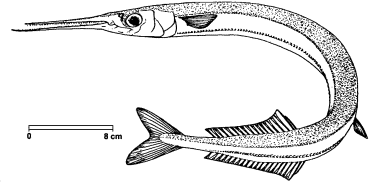
Belone belone euxini (GŁnther, 1866)

Synonyms: Esox belone Pallas, 1811; Belone rostrata Nordman, 1840; Belone belone Borna, 1929; Belone acus euxini Popov, 1930.
Common names: Engl: Garfish; Bulg: Zargan; Georg: Sarghani; Rom: Zargan; Russ: Sargan; Turk: Zargana baligi; Ukr: Sargan.
Order (Scientific): BELONIFORMES.
Family (Scientific): BELONIDAE.
Taxonomic description: Body very elongate, almost cylindrical in section; head prolonged into a beak-like snout very long and sharp; lower jaw longer than upper one so that the mouth is superior; small teeth on the jaw margins and a row of strong, sharp and spaced internal teeth; large, near, triangular nostrils; the dorsal and anal fins are similar in shape and inserted far behind the mid-point of the body; neither fin has finlets; dorsal fin margin slightly concave; pectoral fins with wide base and sharp top; caudal fin deep emarginate, lower lobe shorter that the upper one; the lateral line runs along the belly from the gill opening to near the tail; gill rakers are present (to be seen after detaching the gill cover); scales easily detached, except along the lateral line; back greenish-blue, sides and belly silvery, the latter with a yellow tinge; pelvic and anal fins yellowish with dark tips; the other fins are dark.
 IUCN
Status:
IUCN
Status:
World level:
Black Sea Regional level: EN
Subregion level: EN (Ukrainian sector)
Distribution: All Black Sea coastal waters, Sea of Azov, Sivash lagoon, Sinoe lagoon, Mediterranean Sea and Atlantic Ocean (Belone belone).
Habitat type, Critical habitats, Limiting factors: Coastal waters. Young specimens are most common near the Cystoseira and Zostera belts. The critical habitat is the surface microlayer. Main limiting factors are the pollution of the surface microlayer, and the reduction of the Cystoseira and Zostera biocoenoses.
Biology: A coastal pelagic carnivore fish feeding mainly on anchovy (Engraulis encrasicholus ponticus) and silverside (Atherina mochon pontica). Spawning occurs from May to September. Its filament-bearing eggs, nearly 2 mm in diameter, are attached to algae (Cystoseira) or sea grasses (Zostera). Newly hatched larvae 9-12 mm long, are intensively coloured in brown and appear like floating fragments of Cystoseira. Young fish 5-10 cm long are green coloured resembling floating leaves of Zostera. Both larvae and young fish occur in the neuston layer 0-5 cm.
Population trends: A sharp decline in population numbers since the early 1980s. A reduction of at least 50% over the last 10 years according to direct observations.
Threats: Pollution of the surface microlayer of water, considerable reduction of Cystoseira and Zostera meadows, and decline in anchovy population.
Conservation measures taken: None.
Conservation measures proposed: Enter in the Black Sea Red Data Book. Reduction of coastal waters pollution.
References:
Compiled by: G.Radu, F.Verioti, Yu.Zaitsev, A.Komakhidze.